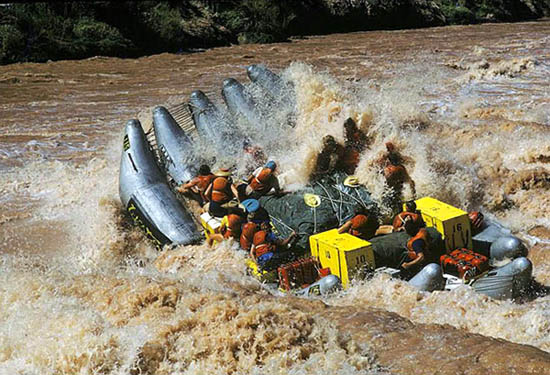Georgie Clark
by Roger Kaza
Today, let's go whitewater rafting. The University of Houston's Music School presents this program about the machines that make our civilization run, and the people whose ingenuity created them.
LIFE Magazine was famous for disaster photos, and here's one for you to picture: a 37 foot rubber raft, standing on edge, dumping its human cargo into the muddy rapids of the Colorado River. It's a disaster with a happy ending -- everyone lives to tell their grandchildren about it. Today, we take commercial whitewater rafting tours for granted. And for that we can thank a petite, middle-aged realtor from Los Angeles, Georgie Clark.
Georgie Clark was born in Oklahoma in 1910. She married at 17 and moved to New York. A few years later she announced to her husband they were moving to California -- by bicycle. She broke her wrist on the way out of town, but kept riding anyway. Eventually they ended up in Los Angeles, where she joined a cycling club. But while she and her 15 year-old daughter were bicycling one evening, the two were struck by a hit-and-run driver. Georgie survived; her daughter did not. Numb with grief, she holed up in her apartment for weeks. Finally a friend dragged her out to see a photographer's slideshow of the Grand Canyon. When it was over, Georgie asked the photographer to take her along on his next trip. Before long, she was leading the trips, and proposing that the two explore the Grand Canyon not by foot, but by water.
Georgie's first trips down the Colorado were so sparsely outfitted they made Outward Bound seem like Club Med. She brought no camping equipment -- in fact, not even a boat. Instead, she and her partner donned bulky Mae West lifejackets, locked arms and jumped into the river. They swam the Grand Canyon. Several years later, when she had scraped together enough money to buy a surplus Navy rubber raft, she said it felt like "riding the Queen Mary." Only a handful had run the Colorado in 1945; certainly no one had ever swum it, at least on purpose.
She did the trips for fun at first, splitting the costs with friends. But before long, Georgie and her "river rats" had a cult following. She made her trips relatively safe by tying three rafts together -- eventually, three enormous pontoon boats. This so-called "G-rig" was a floating island, powered by an inboard motor. It could carry 50 people at a time. The wiry Georgie sat at the helm in her leopard skin bathing suit, the throttle in one hand and a beer in the other. The era of commercial rafting had begun. By 1972, rafting the canyon had become so popular that Georgie and her imitators threatened to overrun the Colorado River. The National Park Service stepped in with quotas and licenses. Today, a permit to run commercial trips on the Colorado would cost you millions of dollars, if you could even find one.
In 1991, Georgie guided her last trip down the canyon, after 47 years on the river. She was 80 years old. She died a year later. In 2001, a rapid was named in her honor in Grand Canyon. But it was a controversial decision. Georgie had never cozied up to the rules and regulations her pioneering had brought about; for her the Colorado was the freedom given to a grieving mother decades before. She had her detractors. In the end, though, the rapid now known as Georgie Rapid is an apt memorial. As one river rat put it, "That thing kicks you in the rear-end, as you go through." Just like Georgie.
I'm Roger Kaza at the University of Houston, where we're interested in the way inventive minds work.
G. Clark (with Duane Newcomb) Georgie Clark -- Thirty Years of River Running. (San Francisco: Chronicle Books, 1977).
D. Westwood, Woman of the River: Georgie White Clark, White Water Pioneer. (Logan UT: Utah State University Press, 1997).

Giant inflatables like this "J-Rig" transformed rafting on the Colorado. Georgie's "G-Rig" was similar, but used pontoon boats. Photo by John Blaustein. http://www.johnblaustein.com/